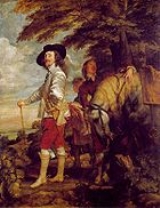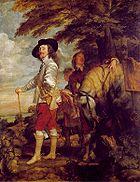
Robert Baron
Encyclopedia
Robert Baron was a Scottish
theologian and one of the so-called Aberdeen doctors
. He is commemorated in the Calendar of saints
of the Scottish Episcopal Church
on 28 March.
, he was the younger son of John Baron of Kinnaird. After graduating from the University of St Andrews
in 1613, he became a teacher of Philosophy
there until, in 1619, he entered the ministry and took charge of parish of Keith
. In the latter charge his predecessor had been the famous Patrick Forbes
.
 He held this position until 27 October 1624, when he was translated to Greyfriars
He held this position until 27 October 1624, when he was translated to Greyfriars
parish, Aberdeen
. In the following year, on 21 December 1625, he was appointed as the first Professor of Divinity
at Marischal College
, a post he would hold simultaneously with his charge at Greyfriars. In 1627, he earned his Doctorate in Divinity
, the thesis for which began a long theological dispute with George Turnbull, a Scottish Jesuit theologian.
Baron was a firm supporter of the Anglicanising
religious policies of Kings James VI and Charles I. He opposed the National Covenant of 1638 both through preaching and writings, including three tracts that were co-authored with John Forbes
, both of whom, along with four others, were referred to by the Presbyterians as "the Aberdeen doctors
". In this year Baron was nominated to be Bishop of Orkney
, but was unable to receive consecration. He fled to England
in the Spring of 1639 to avoid being forced to sign the National Covenant. He was on his way back to Scotland later in the year, but fell ill and died at Berwick-upon-Tweed
on 19 August 1639.
Baron married once, to Jean née Gibson, a girl from Strathisla in Aberdeenshire
. They had four children. Baron left a great number of published and unpublished works. After his death the Covenanters forced his widow to allow them to see his papers, after which they accused him of Arminianism
. Following the Restoration, the crown paid his family £200 in reward for his loyalty to King Charles I.
Scottish people
The Scottish people , or Scots, are a nation and ethnic group native to Scotland. Historically they emerged from an amalgamation of the Picts and Gaels, incorporating neighbouring Britons to the south as well as invading Germanic peoples such as the Anglo-Saxons and the Norse.In modern use,...
theologian and one of the so-called Aberdeen doctors
Aberdeen doctors
The Aberdeen doctors is a term given to a group of six scholars working at Marischal College and King's College, Aberdeen. Until 1635, they enjoyed the leadership of Patrick Forbes, Bishop of Aberdeen. They are distinguishable not only for their positions at Aberdeen, but also by their opposition...
. He is commemorated in the Calendar of saints
Calendar of saints (Scottish Episcopal Church)
In the Calendar of the Scottish Episcopal Church, each Holy and Saint’s Day listed has been assigned a number which indicates its category. It is intended that feasts in categories 1 - 4 should be kept by the whole Church. Days in categories 5 and 6 may be kept according to diocesan or local...
of the Scottish Episcopal Church
Scottish Episcopal Church
The Scottish Episcopal Church is a Christian church in Scotland, consisting of seven dioceses. Since the 17th century, it has had an identity distinct from the presbyterian Church of Scotland....
on 28 March.
Life
Born in 1596 at Kinnaird, GowrieKinnaird, Gowrie
Kinnaird is a village in Gowrie, Perthshire, Scotland. It is notable for its 15th century castle and early 19th century parish church. In the 18th century, it was the home of the Reverend James Adams, who contributed to the Marrow Controversy in the church of Scotland...
, he was the younger son of John Baron of Kinnaird. After graduating from the University of St Andrews
University of St Andrews
The University of St Andrews, informally referred to as "St Andrews", is the oldest university in Scotland and the third oldest in the English-speaking world after Oxford and Cambridge. The university is situated in the town of St Andrews, Fife, on the east coast of Scotland. It was founded between...
in 1613, he became a teacher of Philosophy
Philosophy
Philosophy is the study of general and fundamental problems, such as those connected with existence, knowledge, values, reason, mind, and language. Philosophy is distinguished from other ways of addressing such problems by its critical, generally systematic approach and its reliance on rational...
there until, in 1619, he entered the ministry and took charge of parish of Keith
Keith
Keith may refer to:People*Keith *Keith * Baron Keith, line of Scottish barons in the late 18th century* Clan Keith, Scottish clan associated with lands in northeastern and northwestern Scotland...
. In the latter charge his predecessor had been the famous Patrick Forbes
Patrick Forbes
Patrick Forbes was a late 16th century and early 17th century Scottish churchman. Born in 1564, he was the oldest son of Elizabeth Strachan and her husband William Forbes, Laird of Corse. He attended the High School of Stirling, the University of Glasgow and then the University of St Andrews...
.

Greyfriars
Greyfriars may refer to:* the Franciscan Order of Friars Minor, in particular the Conventual Franciscans* Greyfriars Kirk, Edinburgh, a church* Greyfriars Bobby, a renowned dog in Edinburgh* Greyfriars Kirkyard, a graveyard in Edinburgh...
parish, Aberdeen
Aberdeen
Aberdeen is Scotland's third most populous city, one of Scotland's 32 local government council areas and the United Kingdom's 25th most populous city, with an official population estimate of ....
. In the following year, on 21 December 1625, he was appointed as the first Professor of Divinity
Divinity (academic discipline)
Divinity is the study of Christian and other theology and ministry at a school, divinity school, university, or seminary. The term is sometimes a synonym for theology as an academic, speculative pursuit, and sometimes is used for the study of applied theology and ministry to make a distinction...
at Marischal College
Marischal College
Marischal College is a building and former university in the centre of the city of Aberdeen in north-east Scotland. The building is owned by the University of Aberdeen and used for ceremonial events...
, a post he would hold simultaneously with his charge at Greyfriars. In 1627, he earned his Doctorate in Divinity
Doctor of Divinity
Doctor of Divinity is an advanced academic degree in divinity. Historically, it identified one who had been licensed by a university to teach Christian theology or related religious subjects....
, the thesis for which began a long theological dispute with George Turnbull, a Scottish Jesuit theologian.
Baron was a firm supporter of the Anglicanising
Anglicanism
Anglicanism is a tradition within Christianity comprising churches with historical connections to the Church of England or similar beliefs, worship and church structures. The word Anglican originates in ecclesia anglicana, a medieval Latin phrase dating to at least 1246 that means the English...
religious policies of Kings James VI and Charles I. He opposed the National Covenant of 1638 both through preaching and writings, including three tracts that were co-authored with John Forbes
John Forbes (theologian)
John Forbes of Corse was a Scottish minister and theologian, one of the Aberdeen doctors, noted for his eirenic approach in church polity and opposition to the National Covenant.-Life:...
, both of whom, along with four others, were referred to by the Presbyterians as "the Aberdeen doctors
Aberdeen doctors
The Aberdeen doctors is a term given to a group of six scholars working at Marischal College and King's College, Aberdeen. Until 1635, they enjoyed the leadership of Patrick Forbes, Bishop of Aberdeen. They are distinguishable not only for their positions at Aberdeen, but also by their opposition...
". In this year Baron was nominated to be Bishop of Orkney
Bishop of Orkney
The Bishop of Orkney was the ecclesiastical head of the Diocese of Orkney, one of thirteen medieval bishoprics within the territory of modern Scotland. It included both Orkney and Shetland. It was based for almost all of its history at St...
, but was unable to receive consecration. He fled to England
England
England is a country that is part of the United Kingdom. It shares land borders with Scotland to the north and Wales to the west; the Irish Sea is to the north west, the Celtic Sea to the south west, with the North Sea to the east and the English Channel to the south separating it from continental...
in the Spring of 1639 to avoid being forced to sign the National Covenant. He was on his way back to Scotland later in the year, but fell ill and died at Berwick-upon-Tweed
Berwick-upon-Tweed
Berwick-upon-Tweed or simply Berwick is a town in the county of Northumberland and is the northernmost town in England, on the east coast at the mouth of the River Tweed. It is situated 2.5 miles south of the Scottish border....
on 19 August 1639.
Baron married once, to Jean née Gibson, a girl from Strathisla in Aberdeenshire
Aberdeenshire
Aberdeenshire is one of the 32 unitary council areas in Scotland and a lieutenancy area.The present day Aberdeenshire council area does not include the City of Aberdeen, now a separate council area, from which its name derives. Together, the modern council area and the city formed historic...
. They had four children. Baron left a great number of published and unpublished works. After his death the Covenanters forced his widow to allow them to see his papers, after which they accused him of Arminianism
Arminianism
Arminianism is a school of soteriological thought within Protestant Christianity based on the theological ideas of the Dutch Reformed theologian Jacobus Arminius and his historic followers, the Remonstrants...
. Following the Restoration, the crown paid his family £200 in reward for his loyalty to King Charles I.
See also
- Aberdeen doctorsAberdeen doctorsThe Aberdeen doctors is a term given to a group of six scholars working at Marischal College and King's College, Aberdeen. Until 1635, they enjoyed the leadership of Patrick Forbes, Bishop of Aberdeen. They are distinguishable not only for their positions at Aberdeen, but also by their opposition...
- Patrick ForbesPatrick ForbesPatrick Forbes was a late 16th century and early 17th century Scottish churchman. Born in 1564, he was the oldest son of Elizabeth Strachan and her husband William Forbes, Laird of Corse. He attended the High School of Stirling, the University of Glasgow and then the University of St Andrews...

